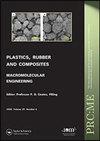建筑材料木塑复合材料恒载长期蠕变试验寿命预测及模型分析
IF 1.2
4区 材料科学
Q3 MATERIALS SCIENCE, COMPOSITES
引用次数: 0
摘要
以再生聚丙烯(rPP)和橡胶木粉(RWF)为原料,确定了木塑复合材料(WPCs)的最佳配方。研究了rPP和WPCs的力学性能和长期蠕变行为。本研究表明,橡胶木粉含量的增加明显增加了弯曲、压缩和拉伸值。复合材料的模量随RWF用量的增加而线性增加。在20%、30%和40%的极限抗弯强度荷载水平下进行了1000小时的蠕变行为试验。在相同rPP荷载水平下,复合材料的挠度(2.45、4.65和6.68 mm)比WPCs的挠度(1.53、2.41和3.37 mm)更高。确定Burger模型参数的六元模型较好地拟合了WPCs的长期蠕变,并将该挠度结果与四元Burger和幂律模型进行了比较。最后,主曲线可以预测复合材料的寿命。本文章由计算机程序翻译,如有差异,请以英文原文为准。
Lifetime prediction under dead-load long-term creep test and models analysis of wood-plastic composites for building materials
ABSTRACT Optimal formulation of wood-plastic composites (WPCs) from recycled polypropylene (rPP) and rubberwood flour (RWF) was determined. Mechanical properties and long-term creep behaviour of rPP and WPCs were investigated. This study revealed that an increasing of rubberwood flour content clearly increases the flexural, compressive, and tensile values. The modulus of composite samples linearly increased with an increasing amount of RWF. The creep behaviour test with load levels at 20, 30, and 40% of the ultimate flexural strength were conducted for 1000 h. The deflection of the composites at the same load levels of rPP gave the higher creep behaviour (2.45, 4.65, and 6.68 mm) than that of WPCs (1.53, 2.41, and 3.37 mm), respectively. Six-element for determining Burger model parameters was well fitted with the long-term creep of WPCs, this deflection result was compared to four-element Burger and Power law models. Finally, the master curve could predict lifetime of composite materials.
求助全文
通过发布文献求助,成功后即可免费获取论文全文。
去求助
来源期刊

Plastics, Rubber and Composites
工程技术-材料科学:复合
CiteScore
4.10
自引率
0.00%
发文量
24
审稿时长
4 months
期刊介绍:
Plastics, Rubber and Composites: Macromolecular Engineering provides an international forum for the publication of original, peer-reviewed research on the macromolecular engineering of polymeric and related materials and polymer matrix composites. Modern polymer processing is increasingly focused on macromolecular engineering: the manipulation of structure at the molecular scale to control properties and fitness for purpose of the final component. Intimately linked to this are the objectives of predicting properties in the context of an optimised design and of establishing robust processing routes and process control systems allowing the desired properties to be achieved reliably.
 求助内容:
求助内容: 应助结果提醒方式:
应助结果提醒方式:


